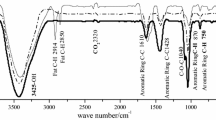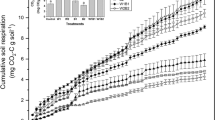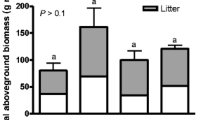Abstract
To mitigate food shortage due to global warming, developing sustainable management practices to stabilize soil organic matter (SOM) and sequester more carbon (C) in the cultivated soils is necessary, particularly in subtropical and tropical areas. A short-term (56 days) incubation experiment was conducted to evaluate the influences of rice husk biochar (RHB) and manure compost (MC) application on C mineralization and nitrogen (N) immobilization in a sandy loam soil. The RHB was separately incorporated into the soil at application rates of 2 and 4% (w/w) either with or without 1% (w/w) compost. Our results displayed that macroaggregates (≥2 mm) were obviously increased by 11% in soil amended with RHB + MC at the end of incubation. In addition, the experimental results presented that the C mineralization of the soil rapidly increased during the first week of incubation. However, the co-application of compost with biochar (RHB + MC) revealed that CO2 emission was significantly decreased by 13–20% compared to the soil with only MC. In addition, the mineralized N in the soil was lower in RHB + MC-amended soil simultaneously than only MC-amended soil, indicating that biochar addition induced N immobilization. The physical protection of compost by its occlusion into aggregates or adsorption on surface of RHB as proved by the micromorphological observation was the main reason for lower C and N mineralization in soil amended with RHB + MC. Overall results revealed that RHB + MC treatment can decrease the decomposition of compost and sequester more C in the tropical agricultural soils.






Similar content being viewed by others
References
Abujabhah IS, Bound SA, Doyle R, Bowman JP (2016) Effects of biochar and compost amendments on soil physico-chemical properties and the total community within a temperate agricultural soil. Ecol Appl 98:243–253. doi:10.1016/j.apsoil.2015.10.021
Agegnehu G, Bass AM, Nelson PN, Muirhead B, Wright G, Bird MI (2015) Biochar and biochar-compost as soil amendments: effects on peanut yield, soil properties and greenhouse gas emissions in tropical North Queensland, Australia. Agric Ecosyst Environ 213:72–85
Agegnehu G, Bass AM, Nelson PN, Bird MI (2016) Benefits of biochar, compost and biochar–compost for soil quality, maize yield and greenhouse gas emissions in a tropical agricultural soil. Sci Total Environ 543:295–306
Ahmad M, Ok YS, Kim BY, Ahn JH, Lee YH, Zhang M, Moon DH, Al-Wabel MI, Lee SS (2016) Impact of soybean stover and pine needle-derived biochars on Pb and As mobility, microbial community, and carbon stability in a contaminated agricultural soil. J Environ Manag 166:131–139
Awad YM, Blagodatskaya E, Ok YS, Kuzyakov Y (2012) Effects of polyacrylamide, biopolymer, and biochar on decomposition of soil organic matter and plant residues as determined by 14C and enzyme activities. Eur J Soil Biol 48:1–10. doi:10.1016/j.ejsobi.2011.09.005
Awad YM, Blagodatskaya E, Ok YS, Kuzyakov Y (2013) Effects of polyacrylamide, biopolymer and biochar on the decomposition of 14C-labelled maize residues and on their stabilization in soil aggregates. Eur J Soil Sci 64:488–499. doi:10.1111/ejss.12034
Awad YM, Lee SS, Ok YS, Kuzyakov Y (2016a) Effects of biochar and polyacrylamide on decomposition of soil organic matter and 14C-labeled alfalfa residues. J Soils Sediments. doi:10.1007/s11368-016-1368-7
Awad YM, Pausch J, Ok YS, Kuzyakov Y (2016b) Interactive effects of biochar and polyacrylamide on decomposition of maize rhizodeposits: implications from 14C labeling and microbial metabolic quotient. J Soils Sediments. doi:10.1007/s11368-016-1576-1
Basso AS, Miguez FE, Laird DA, Horton R, Westgate M (2013) Assessing potential of biochar for increasing water holding capacity of sandy soils. GCB Bioenergy 5(2):132–143
Benito M, Masaguer A, Moliner A, Arrigo N, Palma RM, Effron D (2005) Evaluation of maturity and stability of pruning waste compost and their effect on carbon and nitrogen mineralization in soil. Soil Sci 170(5):360–370
Blair GJ, Lefroy RD, Lisle L (1995) Soil carbon fractions based on their degree of oxidation, and the development of a carbon management index for agricultural systems. Crop Pasture Sci 46(7):1459–1466
Bolan NS, Kunhikrishnan A, Choppala GK, Thangarajan R, Chung JW (2012) Stabilization of carbon in composts and biochars in relation to carbon sequestration and soil fertility. Sci Total Environ 424:264–270
Bremner JM, Mulvaney CS (1982) Nitrogen-total. In: Page AL (ed) Methods of soil analysis. Part 2. Chemical and microbiological properties. ASA and SSSA, Madison, pp 595–624
Busscher WJ, Novak JM, Evans DE, Watts DW, Niandou MAS, Ahmedna M (2010) Influence of pecan biochar on physical properties of a Norfolk loamy sand. Soil Sci 175(1):10–14
Chen CP, Cheng CH, Huang YH, Chen CT, Lai CM, Menyailo OV, Oleg V, Fan LJ, Yang YW (2014) Converting leguminous green manure into biochar: changes in chemical composition and C and N mineralization. Geoderma 232:581–588
Cheng CH, Lehmann J (2009) Ageing of black carbon along a temperature gradient. Chemosphere 75:1021–1027
Cheng CH, Lehmann J, Thies JE, Burton SD, Engelhard MH (2006) Oxidation of black carbon by biotic and abiotic processes. Org Geochem 37(11):1477–1488
Cheng CH, Lehmann J, Engelhard MH (2008) Natural oxidation of black carbon in soils: changes in molecular form and surface charge along a climosequence. Geochim Cosmochim Acta 72(6):1598–1610
Clough TJ, Condron LM, Kammann C, Müller C (2013) A review of biochar and soil nitrogen dynamics. Agronomy 3(2):275–293
Conteh A, Lefroy RDB, Blair GJ (1997) Dynamics of organic matter in soil as determined by variations in 13 C/12 C isotopic ratios and fractionation by ease of oxidation. Aust J Soil Res 35(4):881–890
Cross A, Sohi SP (2011) The priming potential of biochar products in relation to labile carbon contents and soil organic matter status. Soil Bio Biochem 43(10):2127–2134.
Culman SW, Snapp S, Schipanski M, Wander M (2012) Permanganate oxidizable carbon reflects a processed sil fraction that is sensitive to management. Soil Sci Soc Am J 76:494–504
De Neve S, Pannier J, Hofman G (1996) Temperature effects on C-and N-mineralization from vegetable crop residues. In: Progress in nitrogen cycling studies. Springer Netherlands, pp. 41–46
De Neve S, Sleutel S, Hofman G (2003) Carbon mineralization from composts and food industry wastes added to soil. Nutr Cycl Agroecosyst 67(1):13–20
DeLuca TH, MacKenzie MD, Gundale MJ, Holben WE (2006) Wildfire-produced charcoal directly influences nitrogen cycling in ponderosa pine forests. Soil Sci Soc Am J 70(2):448–453. doi:10.2136/sssaj2005.0096
Fernández JM, Nieto MA, López-de-Sá EG, Gascó G, Méndez A, Plaza C (2014) Carbon dioxide emissions from semi-arid soils amended with biochar alone or combined with mineral and organic fertilizers. Sci Total Environ 482:1–7
Gaunt JL, Lehmann J (2008) Energy balance and emissions associated with biochar sequestration and pyrolysis bioenergy production. Environ Sci Technol 42(11):4152–4158
Gee GW, Bauder JW (1986) Particle-size analysis. In: Klute A (ed) Methods of soil analysis. Part 1. Physical and mineralogical methods. ASA and SSSA, Madison, pp 383–411
Hamer U, Marschner B, Brodowski S, Amelung W (2004) Interactive priming of black carbon and glucose mineralisation. Org Geochem 35(7):823–830
Hassen W, Bashir S, Ahmed N, Tanveer M, Shah AN, David J (2016) Labile organic carbon fractions, regulator of CO2 emission: effect of plant residues and water regimes. CLEAN Soil Air Water 44(10):1358–1367
Hussain SS, Ara T, Ahmad FR, Gani G, Hussain N, Hussain M, Dar SR (2015) Quality evaluation of different forms of compost and their effect in comparison with inorganic fertilizers on growth and yield attributes of wheat (Triticum aestivum L.). J Agric Sci 7(1):154–160
Jien SH, Wang CS (2013) Effects of biochar on soil properties and erosion potential in a highly weathered soil. Catena 110:225–233
Jien SH, Wang CC, Lee CH, Lee TY (2015) Stabilization of organic matter by biochar application in compost-amended soils with contrasting pH values and textures. Sustainability 7(10):13317–13333
Kammann CI, Linsel S, Gößling JW, Koyro HW (2011) Influence of biochar on drought tolerance of Chenopodium quinoa Willd and on soil–plant relations. Plant Soil 345(1–2):195–210
Kang SW, Park JW, Seo DC, Ok YS, Park KD, Choi IW, Cho JS (2016a) Effect of biochar application on rice yield and greenhouse gas emission under different nutrient conditions from paddy soil. J Environ Eng 142(10):04016046-1–04016046-6. doi:10.1061/(ASCE)EE.1943-7870.0001083
Kang SW, Seo DC, Cheong YH, Park JW, Park JH, Kang HW, Park KD, Ok YS, Cho JS (2016b) Effect of barley straw biochar application on greenhouse gas emissions from upland soil for Chinese cabbage cultivation in short-term laboratory experiments. J Mt Sci 13(4):693–702
Keeney DRA, Nelson D (1982) Nitrogen-inorganic forms. Methods of soil analysis. Part 2. Chemical and microbiological properties. ASA and SSSA, Madison, pp 643–698
Keith A, Singh B, Singh BP (2011) Interactive priming of biochar and labile organic matter mineralization in a smectite-rich soil. Environ Sci Technol 45(22):9611–9618
Kemper WD, Rosenau RC (1986) Aggregate stability and size distribution. In: Kute A (ed) Methods of soil analysis. Part 1. Physical and mineralogical methods. ASA and SSSA, Madison, pp 425–442
Laird DA (2008) The charcoal vision: a win–win–win scenario for simultaneously producing bioenergy, permanently sequestering carbon, while improving soil and water quality. Agron J 100(1):178–181
Lehmann J, da Silva Jr JP, Steiner C, Nehls T, Zech W, Glaser B (2003) Nutrient availability and leaching in an archaeological Anthrosol and a Ferralsol of the Central Amazon basin: fertilizer, manure and charcoal amendments. Plant Soil 249(2):343–357
Lehmann J, Kuzyakov Y, Pan GX, Ok YS (2015) Biochars and the plant-soil interface. Plant Soil 395:1–5
Liu J, Schulz H, Brandl S, Miehtke H, Huwe B, Glaser B (2012) Short-term effect of biochar and compost on soil fertility and water status of a dystric Cambisol in NE Germany under field conditions. J Plant Nutr Soil Sci 175(5):698–707
Lu K, Yang X, Shen J, Robinson B, Huang H, Liu D, Bolan N, Pei J, Wang H (2014) Effect of bamboo and rice straw biochars on the bioavailability of Cd, Cu, Pb and Zn to Sedum plumbizincicola. Agric Ecosyst Environ 191:124–132
Mandal S, Sarkar B, Bolan N, Novak J, Ok YS, Van Zwieten L, Singh BP, Kirkham MB, Choppala G, Spokas K, Naidu R (2016) Designing advanced biochar products for maximizing greenhouse gas mitigation potential. Crit Rev Environ Sci Technol 46:1367–1401
Mekuria W, Noble A, Sengtaheuanghoung O, Hoanh CT, Bossio D, Sipaseuth N, McCartney M, Langan S (2014) Organic and clay-based soil amendments increase maize yield, total nutrient uptake, and soil properties in Lao PDR. Agroecol Sustain Food Syst 38(8):936–961
Mulvaney RL (1996) Nitrogen-inorganic forms. In: Sparks DL (ed) Methods of soil analysis. Soil Science Society of America Book Series 5 part 3. Chemical methods. SSSA and ASA, Madison, pp 1123–1184
Nelson DW, Sommers LE (1996) Total carbon, organic carbon, and organic matter. In: Sparks DL (ed) Methods of soil analysis. Soil science Society of America Book Series 5 part 3. Chemical methods. SSSA and ASA, Madison, pp 961–1010
Nelson NO, Agudelo SC, Yuan W, Gan J (2011) Nitrogen and phosphorus availability in biochar-amended soils. Soil Sci 176(5):218–226
Qayyum MF, Steffens D, Reisenauer HP, Schubert S (2014) Biochars influence differential distribution and chemical composition of soil organic matter. Plant Soil Environ 60:337–343
Rehman MZ, Rizwan M, Ali S, Fatima N, Yousaf B, Naeem A, Sabir M, Ahmad HR, Ok YS (2016) Contrasting effects of biochar, compost and farm manure on alleviation of nickel toxicity in maize (Zea mays L.) in relation to plant growth, photosynthesis and metal uptake. Ecotoxicol Environ Saf 133:218–225
Rhoades JD (1982) Soluble salts. In: Page AL (ed) Methods of soil analysis. Part 2. Chemical and microbiological properties. ASA and SSSA, Madison, pp 167–179
Robertson G, Groffman P (2007) Nitrogen transformations. In: Paul EA, Clark FE (eds) Soil microbiology and biochemistry. Springer, New York, pp 341–364
Rondon MA, Lehmann J, Ramírez J, Hurtado M (2007) Biological nitrogen fixation by common beans (Phaseolus vulgaris L.) increases with bio-char additions. Biol Fertil Soils 43(6):699–708
Schmidt HP, Kammann C, Niggli C, Evangelou MW, Mackie KA, Abiven S (2014) Biochar and biochar-compost as soil amendments to a vineyard soil: influences on plant growth, nutrient uptake, plant health and grape quality. Agric Ecosyst Environ 191:117–123
Smith JL, Schnabel R, McNeal BL, Campbell GS (1980) Potential errors in the first-order model for estimating soil nitrogen mineralization potentials. Soil Sci Soc Am J 44(5):996–1000
Soil Survey Staff (2014) Keys to soil taxonomy. USDA-NRCS, Agricultural Handbook No. 436, 12th edn. U.S. Government Printing Office, Washington, D.C., USA
Sparks DL, Page AL, Helmke PA, Leoppert RH, Soltanpour PN, Tabatabai MA, Johnston CT, Sumner ME (1996) Methods of soil analysis-soil science society of America book series. ASA and SSA, Madison, pp 199–200
Spokas KA, Cantrell KB, Novak JM, Archer DA, Ippolito JA, Collins HP, Boateng AA, Lima IM, Lamb MC, McAloon AJ, Lentz RD, Nichols KA (2012) Biochar: A synthesis of its agronomic impact beyond carbon sequestration. J Environ Qual 41:973–989
Stewart CE, Zheng J, Botte J, Cotrufo MF (2013) Co-generated fast pyrolysis biochar mitigates green house gas emissions and increases carbon sequestration in temperate soils. GCB Bioenergy 5(2):153–164
Sumner ME, Miller WP (1996) Cation exchange capacity and exchange coefficients. In: Sparks DL (ed) Methods of soil analysis. Soil Science Society of America Book Series 5 part 3. Chemical methods. SSSA and ASA, Madison, pp 1218–1220
Teutscherova N, Vazquez E, Santana D, Navas M, Masaguer A, Benito M (2017) Influence of pruning waste compost maturity and biochar on carbon dynamics in acid soil: incubation study. Eur J Soil Biol 78:66–74. doi:10.1016/j.ejsobi.2016.12.001
Vaccari FP, Baronti S, Lugato E, Genesio L, Castaldi S, Fornasier F, Miglietta F (2011) Biochar as a strategy to sequester carbon and increase yield in durum wheat. Eur J Agron 34(4):231–238
Van Zwieten L, Kimber S, Morris S, Chan KY, Downie A, Rust J, Joseph S, Cowie A (2010) Effects of biochar from slow pyrolysis of papermill waste on agronomic performance and soil fertility. Plant Soil 327(1–2):235–246
Ventura M, Sorrenti G, Panzacchi P, George E, Tonon G (2013) Biochar reduces short-term nitrate leaching from a horizon in an apple orchard. J Environ Qual 42(1):76–82
Woolf D, Amonette JE, Street-Perrott FA, Lehmann J, Joseph S (2010) Sustainable biochar to mitigate global climate change. Nat Commun 1:56
Yoo J, Woo SH, Park KD, Chung KY (2016) Effect of no-tillage and conventional tillage practices on the nitrous oxide (N2O) emissions in an upland soil: soil N2O emission as affected by the fertilizer applications. Appl Biol Chem 59(6):787–797. doi:10.1007/s13765-016-0226-z
Yuan JH, Xu RK, Zhang H (2011) The forms of alkalis in the biochar produced from crop residues at different temperatures. Bioresour Technol 102(3):3488–3497
Zhang M, Ok YS (2014) Biochar soil amendment for sustainable agriculture with carbon and contaminant sequestration. Carbon Manag 5:255–257
Zhang D, Pan G, Wu G, Kibue GW, Li L, Zhang X, Zheng J, Zheng J, Cheng K, Joseph S, Liu X (2016) Biochar helps enhance maize productivity and reduce greenhouse gas emissions under balanced fertilization in a rainfed low fertility inceptisol. Chemosphere 142:106–113
Zhao X, Wang JW, Xu HJ, Zho CJ, Wang SQ, Xing GX (2014) Effects of crop-straw biochar on crop growth and soil fertility over a wheat-millet rotation in soils of China. Soil Use Manag 30(3):311–319
Zheng J, Stewart CE, Cotrufo MF (2012) Biochar and nitrogen fertilizer alters soil nitrogen dynamics and greenhouse gas fluxes from two temperate soils. J Environ Qual 41(5):1361–1370
Zimmerman AR, Gao B, Ahn MA (2011) Positive and negative carbon mineralization priming effects among a variety of biochar amended soils. Soil Bio Biochem 43:1169–1179
Acknowledgments
The authors thank the Ministry of Science and Technology, Republic of China, for financially supporting this research under contract number MOST-103-2313-B-020-007-MY2. The authors are also grateful to Chuan-Chi Chien from the Industrial Technology Research Institute, Tainan, Taiwan, for providing the rice hull biochar.
Author information
Authors and Affiliations
Corresponding author
Additional information
Responsible editor: Zhihong Xu
Rights and permissions
About this article
Cite this article
Jien, SH., Chen, WC., Ok, Y.S. et al. Short-term biochar application induced variations in C and N mineralization in a compost-amended tropical soil. Environ Sci Pollut Res 25, 25715–25725 (2018). https://doi.org/10.1007/s11356-017-9234-8
Received:
Accepted:
Published:
Issue Date:
DOI: https://doi.org/10.1007/s11356-017-9234-8




